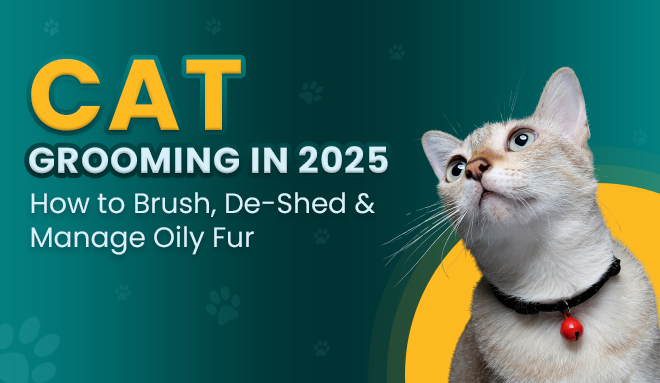We all know cats love grooming themselves, but sometimes, let’s be real, they don’t quite get to all the spots. If you’re here, it’s probably because your cat’s fur is everywhere—or maybe it’s oily? Either way, grooming isn’t just about brushing. It’s about managing that shedding and greasy fur. Let’s get into some cat grooming tips.
Why Grooming is So Important for Cats?
Cats are independent when it comes to grooming. Daily grooming remains essential despite them wanting to do it on their own. The regular grooming process maintains both your cat’s skin condition and coat health.
It helps with:
- Shedding (because who wants fur all over the house?)
- Preventing mats or tangles
- Giving you the chance to check for health issues like skin infections or parasites
Also, the time you spend with your cat during grooming provides valuable bonding opportunities, even if they resist the process. Trust us with this!
What’s the Deal with Shedding?
Shedding is normal in cats, even when the situation quickly spirals into chaos. The shedding patterns of cats vary between constant shedding and seasonal shedding (peaks in spring and fall). Stress, dietary changes or potential health issues can contribute to shedding. And if your cat is dealing with excessive shedding, managing this condition not only helps your cat but also aids in maintaining your home’s cleanliness.
How to Handle Shedding?
To start with, there’s no need to stress about it. These steps will assist you in managing shedding:
1. Brush Regularly
The primary method for controlling shedding is regular brushing. Daily brushing of your cat’s coat should be a habit, even if you can only dedicate a short time. The most effective cat brushing technique involves using a grooming glove for the belly regions, followed by a slicker brush for the rest of their coat.
2. Diet is Key
A cat’s diet plays a key role in maintaining their coat condition. Omega-3s specifically help support a healthy coat. You should consider adding Dorwest Evening Primrose Oil as a dietary supplement to support your cat’s fur health.
3. Hydration Matters
A shiny and healthy coat requires proper hydration. Ensure your feline friend consumes enough water. Since cats show a preference for water that runs instead of stagnant liquid, pet fountains serve as a solution to motivate cats to drink.
Brushing Your Cat—The Right Way
Brushing requires personalized attention because your cat has different needs. Here’s how to do it right:
- Start Slow: Don’t just grab the brush and go for it. Begin with some gentle petting to achieve a state of calmness.
- Go With the Fur: Brush the hair by following its natural direction for better results. Brushing the fur in this way provides gentler care for your cat’s skin.
- Grooming Glove : Use a soft grooming glove for delicate areas like the belly, while a standard brush works best on the back and sides and tail.
- Consistency Over Perfection: Regular brushing stands above a perfect cat brushing technique at all times. The essential factor is maintaining a regular schedule for this practice.
De-Shedding: Tools to Help
During times of intense shedding, the use of de-shedding tools proves highly effective. Such tools extract dead hair from the undercoat to significantly decrease the amount of flying fur.
A rake comb, along with a de-shedding brush, works best for cats with long hair and those who shed extensively. These tools extract hairs that your regular brush cannot.
Older cats and those with mobility issues will benefit from SeaFlex Joint, Skin, and Vitality supplements, as they promote joint and skin wellness, which eases grooming sessions.
Oily Fur: Why Does It Happen?
The presence of oily fur indicates an underlying medical condition that goes beyond normal grooming needs. The feeling of oily fur in cats may suggest either obesity or arthritis.
- Obesity (they can’t reach areas to groom properly)
- Arthritis (it hurts to move or groom)
The causes of oily fur in cats include skin infections alongside hormonal imbalances that impact fur and skin health.
Flat-faced breeds, along with long-haired cats, tend to develop oily fur more frequently, yet this condition affects all felines.
How to Manage Oily Fur?
Take the following steps to take care of your cat’s oily fur.
1. Spot Clean First
Before giving your cat a full bath, start by wiping oily areas with a moist cloth. Because oil accumulates most frequently in the chin, chest, and base of the tail, these areas require extra care.
2. Bathing When Necessary
When the amount of oil buildup becomes intolerable, your pet needs to be bathed. When giving your pet a bath, use a mild shampoo made especially for cats. Purl Advanced Show White Pet Shampoo makes it possible to clean fur without making skin feel parched.
3. Help With Joint Health
When cats are unable to properly groom themselves, they develop oily fur. SeaFlex and other joint support supplements will help your cat move more freely, which will improve their ability to groom themselves.
FAQs
Q: How often should I brush my cat?
A: Daily, ideally. You can effectively control shedding by brushing your cat twice a week.
Q: What if my cat doesn’t like being brushed?
A: Try using a softer brush or a grooming glove. In order to foster a positive grooming experience, start slowly and offer treats.
Q: How do I determine if oily fur indicates any health concerns?
A: If your cat’s oiliness continues while you notice weight fluctuations and hair thinning, you will need to take them to the vet.
Final Thoughts
Cat grooming tips offers both aesthetic advantages as well as necessary comfort and health support. Maintaining your cat’s health will require proper grooming, a balanced diet, and fur management strategies. Doing so can become an effortless and fulfilling daily routine with the right equipment and planned grooming sessions. Your feline pal will show appreciation by purring.

